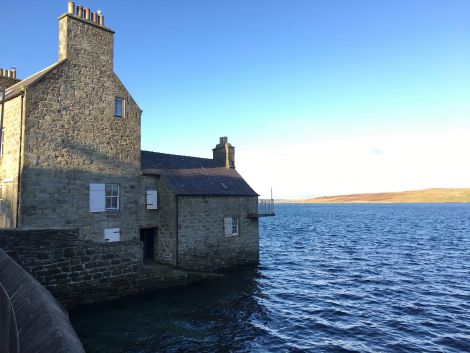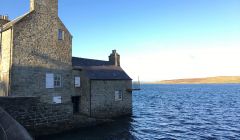News / Environment agency maintains objection to lodberry conversion over flood risk
THE CHANCES of a historic waterfront Lerwick lodberry being turned into a home appear to be increasingly slim after the Scottish Environment Protection Agency (SEPA) reiterated its concern over flooding despite new efforts to mitigate the risk.
Aidan and Tracey Mills, who live in Canada, are keen to turn the former Lerwick Sea Scouts base on Commercial Street – which was built around 1817 – into a home.
SEPA previously objected in principle to the idea over the apparent risk of coastal flooding, and it has now repeated its concerns – leading to Shetland Islands Council planners to suggest the application will likely be recommended for refusal.
A risk assessment previously carried out by engineers Arch Henderson showed that the B-listed building has been susceptible to flooding in the past.
“With tide levels predicted to rise, so will the risk and frequency of flooding,” Arch Henderson’s Karl Tait said.
The lodberry – which was owned by Shetland Islands Council – had been leased to the sea scouts from the 1970s to 2016, but it has been dormant since then, with the inside of the building in poor condition.
Modifications to the plans were submitted in December in an attempt to mitigate the flood risk, including a proposal to extend the existing sea wall along the edge of the building’s pier.
The main kitchen has also been relocated from the ground floor to the first floor, which is above likely flood levels, following concern from SEPA.
There are also plans to install a storm gate for use in poor weather, and fix a new 1,100mm high balustrade railing between the stone wall and the building.
Colin Sim of Malcolmson Architects wrote to Shetland Islands Council planners regarding SEPA’s view that there would be potential increased vulnerability if the building was made into a house, saying that it had originally been a dwelling before the Sea Scouts took it on.
Become a member of Shetland News
While he admitted there are a “number of technical difficulties to overcome to improve the resilience of the building”, Sim said that it is not uncommon for technical solutions to be fully resolved and submitted at the planning stage.
SEPA, however, said it maintained its objection in principle to the application over the “serious flood risk” the building could be placed under.
The government agency recommended alternative sites be considered as it believes that due to the lodberry’s location the project would not meet Scottish planning policy.
Shetland Islands Council’s planning service wrote to the applicant after SEPA’s submission to suggest the likely next steps would be either for the application to be recommended for refusal, or that it is withdrawn.
The planning service had earlier confirmed that an application would need to be submitted to change the use of the property to a dwelling.
Become a member of Shetland News
Shetland News is asking its readers to consider paying for membership to get additional perks:
- Removal of third-party ads;
- Bookmark posts to read later;
- Exclusive curated weekly newsletter;
- Hide membership messages;
- Comments open for discussion.
If you appreciate what we do and feel strongly about impartial local journalism, then please become a member of Shetland News by either making a single payment, or setting up a monthly, quarterly or yearly subscription.































































